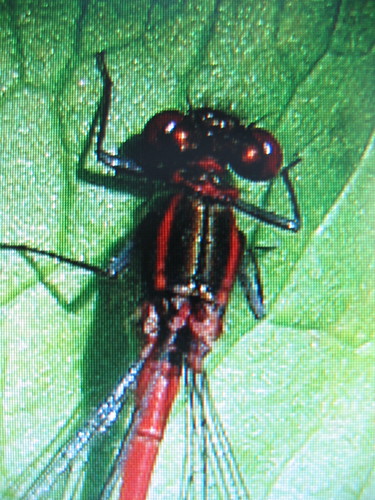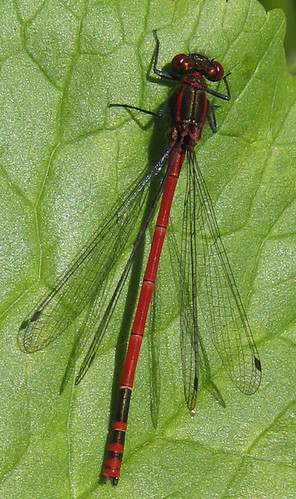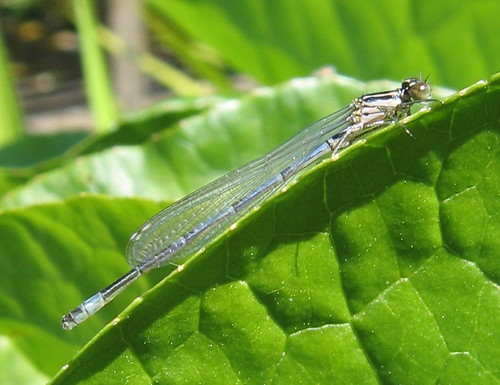Also available super-big on Flickr






Also available super-big on Flickr






It’s remarkable how many different insect species there are around if you go and look, and notice the various colours and sizes instead of just thinking ‘butterfly’ or ‘bumblebee’. Damselflies are the smaller, more delicate relatives of dragonflies. There were at least three species, and possibly four, in the garden today. I got pictures of some of them. This is a Large Red Damselfly:

A Common Blue An Azure Damselfly:

I’ve always assumed this one, which has distinctive grey/silver wings, was a different species, but looking around on Google it may possibly be an alternative colour form of the female Azure:
EDIT: apparently grey wings are typical of newly hatched dragonflies – ‘teneral’ in the jargon – so this is probably a teneral Azure Damselfly.

Pretty, aren’t they.
As well as those, and the Blue tailed Damselfly which I didn’t get a photo of, I’ve also seen at least one other species in the garden in the past – the Red Eyed Damselfly. And that’s without counting the ‘proper’ dragonflies.
If you like invertebrates (and who doesn’t?) check out the Circus of the Spineless at Burning Silo.
I take a casual interest in insects and other invertebrates, but one thing you quickly realise is that they’re really hard. I first really appreciated this when, quite pleased with myself for recognising something as a ‘scorpionfly’, I tried to look it up in a book and discovered there are something like 28 species just of scorpionflies in the UK. And that’s relatively modest compared to the beetles and things. So I mainly stick to birds.
Since I’m on natural history, check out the dioramas at Pruned; it’s worth clicking through the links in that post as well.
How did we ever get along without the internet to help us scratch those little itches of curiosity? Admittedly, most of them seem to be along the lines of “What have I seen that bloke in before? Oh, I see, he was in [embarrassingly awful sitcom I couldn’t possibly admit to watching]”, but still.
Anyway, in the woods the other day I saw a curious-looking insect, and I just got round to looking it up. Starting by googling ‘day-flying moths uk’ and going from there I came up with Adela reaumurella:

(photo from the fabulous UKMoths website and © Charles Baker)
Like a lot of insects, no-one has bothered to give it an English name, but apparently there are a couple of families of moths with these characteristic antennae, and they’re generally referred to as ‘longhorn moths’. You can see the peculiar antennae above, but the picture doesn’t give the full effect, because when I saw them they were flying all around each other in a little swarm in the sun above a hornbeam, holding their antennae up in a V shape for maximum visibility.
I’m guessing the lady moths like a male with a long horn; that it was, in fact, a moth lek. A lek is where lots of males congregate to compete for female attention, either directly (i.e. by fighting for the best spot), or indirectly (displaying their plumage) or some combination. Insert your own Essex nightclub joke here.
It’s not quite as exciting as having lekking Black Grouse, Ruff, or even hermits (check out the video!), but I was pleased.
One example of lekking behaviour is actually very familiar, although people don’t generally realise what’s happening. On a summer evening, you’ll frequently encounter a swarm of midges flying round and round above a prominent object like a bush. If you walk past them, they often follow you and swarm above your head instead. They are in fact lekking. The males find a convenient landmark and form a swarm, waiting for the females to find them. I assume that in some situations it’s just more efficient to attract the females to one place and then compete directly with other males than it is to expend the energy finding the females individually. I have no idea how the female midges decide which males are the attractive ones.
An interesting story about darwinulids. As far as anyone could tell, darwinulids (a type of crustacean) had been reproducing exclusively asexually for 200,000,000 years, but now a researcher has found 3 male specimens, which implies that at least one darwinulid species has sex.
Sex is a bit mysterious in evolutionary terms because it’s so much more efficient to reproduce asexually. Quite apart from the time-consuming business of finding a mate, sexual reproduction needs twice as many adults to produce the same number of offspring, and when you do breed, only half your own genes end up in the child anyway. That’s a huge reproductive disadvantage; yet pretty much all animals have sex. So it must offer some kind of dramatic short-term advantage to compensate for that reduced breeding rate. Even animals like aphids, which mainly breed asexually (aphids are born pregnant!) occasionally produce a few males and breed sexually as well.
The most popular theory is apparently that it helps fight disease and parasites – read The Red Queen by Matt Ridley for the details – but certainly its omnipresence implies that sex serves some kind of vital role. Which makes it hard to explain the few groups of animals that seem to have been merrily getting along without for tens of millions of years. If it is confirmed that darwinulids have been secretly shagging away somewhere all along, it removes an anomaly. That still leaves the marvellously named bdelloid rotifers, who have apparently been holding out for 40,000,000 years.
Although my own main interest is birds, I think if I was advising someone on a natural-history related hobby to take up, I might suggest flowers or insects. I think it’s a great virtue to look closely at the little things. You miss the real action if you tromp through the hills, admiring the view but not noticing the wild flowers at your feet.
You don’t have to pick just one interest, of course. I did much of my early birding with one of my teachers who was also keen on flowers and had a moth trap. He was the one who showed me that, if you look the wrong way through binoculars and bring them very close to something, they act as a powerful magnifying glass.